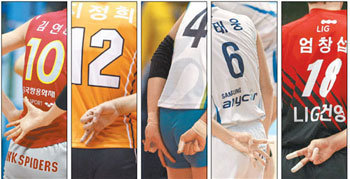Hand Signals on the Volleyball Court
Hand Signals on the Volleyball Court
Posted December. 15, 2007 03:36,

I am going this way! Okay! I am hitting that way! A swift attack this time While players are serving balls on both sides of the volleyball court, their fingers and hands look busy. Using their hands behind their backs, hips or under their side, players secretly communicate with other players on their team. The receiving team uses hand signs to prepare for the next attack while the serving team gives them out for defense against the opponents possible movements. As the players on the opposite side can hear what the team members say, players on the court resort to using hand signals.
Hand signals are what make teams work based on left/right side open attacks, various kinds of swift attacks and back attacks combined with setters service systems. Unlike other sports such as football and basketball, which involve an intense degree of scuffle, volleyball requires more of a kind of scenario.
To minimize mistakes, players need to accurately read opponents possible movements, let other teammates know of next attack routes and attack opponents weaknesses with prompt decision-making.
Primarily, setters, centers, and libero players use hand signals. A setter orders directions for left/right open attacks, delayed spiking, swift attacks and back attacks as he or she sees the flow of the ball received on the other side. Following the setters sign as he or she flies the ball, center players indicate their attack routes: left-side, center back attack, center delayed spiking, using hand signs.
Kim Yeon-gyeong, one of the top center players of Hungkuk Life Insurance, said, As players know how other players will move via signals, fewer mistakes occur regardless of how a setter flies the ball.
Libero players use a sign when the team serves to direct the service direction toward one of the opponents who is a weak receiver. As libero players focus on the defense, they zero in on who is a weak receiver. Center players use signs to direct the blocking direction and whether he or she will participate in a swift attack. Kim Ho-cheol, Hyundai Capital team director, said, Depending on situations, the coaching staff changes its tactics, and players immediately adapt to new strategies through a change in their hand signals.
A missed spike occurs, though rarely, as a result of miscommunication. Systemic team work on the volleyball court is possible thanks to players hand signals.
yjongk@donga.com




![라면 5만 개 끓여 보며 성능 테스트… “무인점 라면 조리기 95% 차지”[유레카 모멘트]](https://dimg.donga.com/c/138/175/90/1/wps/NEWS/IMAGE/2025/12/27/133042717.4.jpg)

